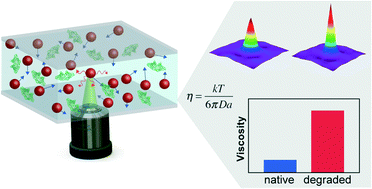Our official English website, www.x-mol.net, welcomes your feedback! (Note: you will need to create a separate account there.)
Measuring biotherapeutic viscosity and degradation on-chip with particle diffusometry
Lab on a Chip ( IF 6.1 ) Pub Date : 2017-11-01 00:00:00 , DOI: 10.1039/c7lc00507e K. N. Clayton 1, 2, 3, 4 , D. Lee 1, 2, 3, 4 , S. T. Wereley 1, 2, 3, 4 , T. L. Kinzer-Ursem 2, 3, 4, 5
Lab on a Chip ( IF 6.1 ) Pub Date : 2017-11-01 00:00:00 , DOI: 10.1039/c7lc00507e K. N. Clayton 1, 2, 3, 4 , D. Lee 1, 2, 3, 4 , S. T. Wereley 1, 2, 3, 4 , T. L. Kinzer-Ursem 2, 3, 4, 5
Affiliation

|
In the absence of efficient ways to test drug stability and efficacy, pharmaceuticals that have been stored outside of set temperature conditions are destroyed, often at great cost. This is especially problematic for biotherapeutics, which are highly sensitive to temperature fluctuations. Current platforms for assessing the stability of protein-based biotherapeutics in high throughput and in low volumes are unavailable outside of research and development laboratories and are not efficient for use in production, quality control, distribution, or clinical settings. In these alternative environments, microanalysis platforms could provide significant advantages for the characterization of biotherapeutic degradation. Here we present particle diffusometry (PD), a new technique to study degradation of biotherapeutic solutions. PD uses a simple microfluidic chip and microscope setup to calculate the Brownian motion of particles in a quiescent solution using a variation of particle image velocimetry (PIV) fundamentals. We show that PD can be used to measure the viscosity of protein solutions to discriminate native protein from degraded samples as well as to determine the change in viscosity as a function of therapeutic concentration. PD viscosity analysis is applied to two particularly important biotherapeutic preparations: insulin, a commonly used protein for diabetic patients, and monoclonal antibodies which are an emerging class of biotherapeutics used to treat a variety of diseases such as autoimmune disorders and cancer. PD-based characterization of solution viscosity is a new tool for biotherapeutic analysis, and owing to its easy setup could readily be implemented at key points of the pharmaceutical delivery chain and in clinical settings.
中文翻译:

用粒子扩散法在芯片上测量生物治疗粘度和降解
在缺乏测试药物稳定性和功效的有效方法的情况下,通常以高昂的代价销毁储存在设定温度条件之外的药物。对于对温度波动高度敏感的生物治疗学,这尤其成问题。在研发实验室之外无法获得用于评估高通量和小批量蛋白质基生物治疗药物稳定性的当前平台,并且无法有效地用于生产,质量控制,分销或临床环境。在这些替代环境中,微量分析平台可为表征生物治疗药物降解提供重要优势。在这里,我们介绍了粒子扩散法(PD),这是一种研究生物治疗溶液降解的新技术。PD使用简单的微流控芯片和显微镜设置,使用粒子图像测速(PIV)基本原理的变化来计算静态溶液中粒子的布朗运动。我们表明PD可用于测量蛋白质溶液的粘度,以区分降解样品中的天然蛋白质,以及确定粘度随治疗浓度的变化。PD粘度分析适用于两种特别重要的生物治疗制剂:胰岛素(一种糖尿病患者常用的蛋白质)和单克隆抗体,它们是新兴的一类用于治疗各种疾病(例如自身免疫性疾病和癌症)的生物治疗剂。基于PD的溶液粘度表征是生物治疗分析的新工具,
更新日期:2017-11-08
中文翻译:

用粒子扩散法在芯片上测量生物治疗粘度和降解
在缺乏测试药物稳定性和功效的有效方法的情况下,通常以高昂的代价销毁储存在设定温度条件之外的药物。对于对温度波动高度敏感的生物治疗学,这尤其成问题。在研发实验室之外无法获得用于评估高通量和小批量蛋白质基生物治疗药物稳定性的当前平台,并且无法有效地用于生产,质量控制,分销或临床环境。在这些替代环境中,微量分析平台可为表征生物治疗药物降解提供重要优势。在这里,我们介绍了粒子扩散法(PD),这是一种研究生物治疗溶液降解的新技术。PD使用简单的微流控芯片和显微镜设置,使用粒子图像测速(PIV)基本原理的变化来计算静态溶液中粒子的布朗运动。我们表明PD可用于测量蛋白质溶液的粘度,以区分降解样品中的天然蛋白质,以及确定粘度随治疗浓度的变化。PD粘度分析适用于两种特别重要的生物治疗制剂:胰岛素(一种糖尿病患者常用的蛋白质)和单克隆抗体,它们是新兴的一类用于治疗各种疾病(例如自身免疫性疾病和癌症)的生物治疗剂。基于PD的溶液粘度表征是生物治疗分析的新工具,



























 京公网安备 11010802027423号
京公网安备 11010802027423号